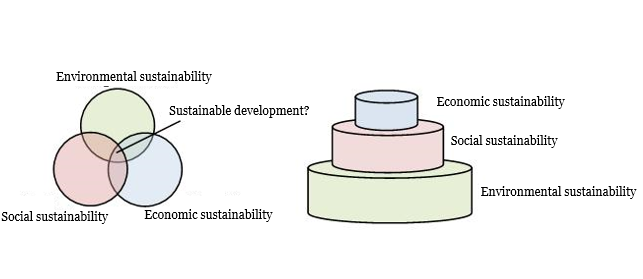Sustainable Development
Everyone knows the concept of sustainable development. Nevertheless, it is often frustratingly difficult to put your finger on exactly what the concept means.
Sustainable development is a concept used to identify a desirable societal development. Perhaps the most common definition of the concept comes from the Brundtland Commission's report "Our Common Future", published in 1987:

But what does this mean in practice? One way to make the concept more concrete is to define it in terms of different dimensions or categories of phenomena, resources and processes, such as by discussing ecological, social and economic sustainability, for example.
Two models over three dimensions
A common way of describing how these different dimensions are connected is through a Venn diagram where they overlap each other. This model conveys a representation of sustainable development where all three dimensions are given equal weight and value. An alternative way of describing sustainable development is in the form of a hierarchy where ecological sustainability is given fundamental importance and is seen as a precondition for both social and economic sustainability. These two dimensions are also characterised by a relationship of dependency, where social sustainability is the basis for economic sustainability to be possible.

However, these models say nothing, of course, about the content of the different dimensions. Nor do they say anything about whether the relationships - the contact areas - between the different dimensions are considered to be characterised by synergies or conflicts. In many cases, where the content of sustainability and its interrelationships are defined, this is often described in general terms. Such overall definitions can be considered as being frustratingly vague but can still perform an important function. This primarily applies to economic sustainability, where there are two common, but fundamentally different, definitions.
Three dimensions of sustainable development
Ecological sustainability
Social sustainability
Economic sustainability
